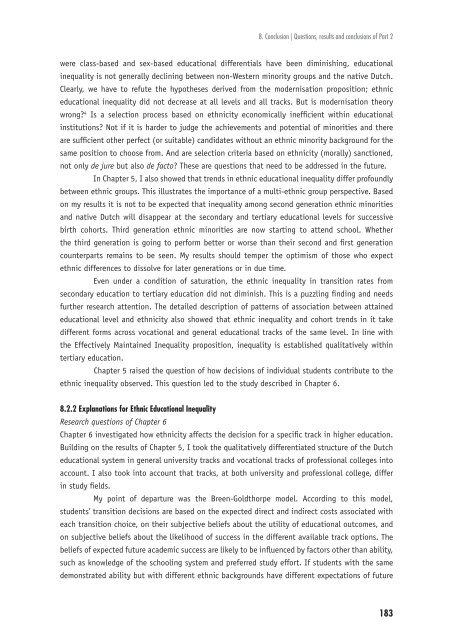Ethnic Hostility among Ethnic Majority and Minority Groups
Ethnic Hostility among Ethnic Majority and Minority Groups
Ethnic Hostility among Ethnic Majority and Minority Groups
Create successful ePaper yourself
Turn your PDF publications into a flip-book with our unique Google optimized e-Paper software.
8. Conclusion | Questions, results <strong>and</strong> conclusions of Part 2<br />
were class-based <strong>and</strong> sex-based educational differentials have been diminishing, educational<br />
inequality is not generally declining between non-Western minority groups <strong>and</strong> the native Dutch.<br />
Clearly, we have to refute the hypotheses derived from the modernisation proposition; ethnic<br />
educational inequality did not decrease at all levels <strong>and</strong> all tracks. But is modernisation theory<br />
wrong? 4 Is a selection process based on ethnicity economically ineffi cient within educational<br />
institutions? Not if it is harder to judge the achievements <strong>and</strong> potential of minorities <strong>and</strong> there<br />
are suffi cient other perfect (or suitable) c<strong>and</strong>idates without an ethnic minority background for the<br />
same position to choose from. And are selection criteria based on ethnicity (morally) sanctioned,<br />
not only de jure but also de facto? These are questions that need to be addressed in the future.<br />
In Chapter 5, I also showed that trends in ethnic educational inequality differ profoundly<br />
between ethnic groups. This illustrates the importance of a multi-ethnic group perspective. Based<br />
on my results it is not to be expected that inequality <strong>among</strong> second generation ethnic minorities<br />
<strong>and</strong> native Dutch will disappear at the secondary <strong>and</strong> tertiary educational levels for successive<br />
birth cohorts. Third generation ethnic minorities are now starting to attend school. Whether<br />
the third generation is going to perform better or worse than their second <strong>and</strong> fi rst generation<br />
counterparts remains to be seen. My results should temper the optimism of those who expect<br />
ethnic differences to dissolve for later generations or in due time.<br />
Even under a condition of saturation, the ethnic inequality in transition rates from<br />
secondary education to tertiary education did not diminish. This is a puzzling fi nding <strong>and</strong> needs<br />
further research attention. The detailed description of patterns of association between attained<br />
educational level <strong>and</strong> ethnicity also showed that ethnic inequality <strong>and</strong> cohort trends in it take<br />
different forms across vocational <strong>and</strong> general educational tracks of the same level. In line with<br />
the Effectively Maintained Inequality proposition, inequality is established qualitatively within<br />
tertiary education.<br />
Chapter 5 raised the question of how decisions of individual students contribute to the<br />
ethnic inequality observed. This question led to the study described in Chapter 6.<br />
8.2.2 Explanations for <strong>Ethnic</strong> Educational Inequality<br />
Research questions of Chapter 6<br />
Chapter 6 investigated how ethnicity affects the decision for a specifi c track in higher education.<br />
Building on the results of Chapter 5, I took the qualitatively differentiated structure of the Dutch<br />
educational system in general university tracks <strong>and</strong> vocational tracks of professional colleges into<br />
account. I also took into account that tracks, at both university <strong>and</strong> professional college, differ<br />
in study fi elds.<br />
My point of departure was the Breen-Goldthorpe model. According to this model,<br />
students’ transition decisions are based on the expected direct <strong>and</strong> indirect costs associated with<br />
each transition choice, on their subjective beliefs about the utility of educational outcomes, <strong>and</strong><br />
on subjective beliefs about the likelihood of success in the different available track options. The<br />
beliefs of expected future academic success are likely to be infl uenced by factors other than ability,<br />
such as knowledge of the schooling system <strong>and</strong> preferred study effort. If students with the same<br />
demonstrated ability but with different ethnic backgrounds have different expectations of future<br />
183












